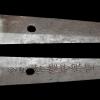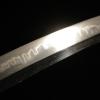Hi everyone, new to collecting, this is my first, possibly my only as I don't think I can afford investment in another. Just picked up an O-Wakisashi(? 21.1", is this O-wakisashi or simply wakisashi) signed by Tada Hitachi no Kami Muneshige. I can find precious little about this swordsmith, what I did find did not include Tada and I even wonder if it's the Singnature with and without "tada" is same smith. The sword is authentic with nbthk green papers, (especially precious, issued 1971) It is stunning and will post pics in the near future, right now trying to research the smith and his creds. I did an internet search and found a book reference, but the text is hard to decipher, I am led to believe "tada" might be the smiths original real name, however the characters ,might also have a meaning. 妙 which has a few meanings as far as I can see on the internet; clever, wonderful, Superior. On this board I find this but there is little info as far as creds, was this a superior or average smith, etc; I think "Kami" is an honorary cred, meaning "god spirit" and was supposedly as high as you could get at that period. I'll try to upload a pic of the hamon, quite lively and if anyone would care to comment on that I would appreciate it too If anyone can help I appreciate it |
|||
 |
Nihonto ClubJapanese Sword Information Exchange |
User login |
|
|
Disclaimer: Nihontō Club owners and independent contributors will not be held responsible for any loss, damage or inconvenience caused as a result of any inaccuracy or error within this website. Except where otherwise noted, this page is licensed under a Creative Commons License.
|



mei
Hi, Were you going to post a picture of the mei?
O-wakizashi: There are no firm rules on these terms - just "wakizashi" is fine, in my opinion.
Tada: Just an off-hand guess that "tada" is not the correct reading, but we'll see...
Kami: This is an honorary title, given to many smiths. It doesn't really say very much about the relative skill or importance of the smith. Many VERY IMPORTANT smiths don't have a special title in their signatures. The literal meaning of the "kami" kanji is irrelevant. Even though he had the "Hitachi no Kami" title, he may not have had any association with Hitachi province. "DAIJOu" is another similar title.
Pete
Tada
Just noticed that MUN396 shows a "TADA..." signature example.
Does yours match that? If so, then "Tada" is indeed the correct reading, and it could be a family name for the smith, or perhaps the name of a town/village.
Pete
Thanks for the info
Thanks for the info Pete
seems I can't figure out how to upload pics of the mei in this box so I added that to the first post
Tada
Confirmed - the signature is what you said, and is what is shown for MUN396.
Pete
Thank you Pete
Thank you Pete
Would you say the signature with and without the "tada" on different blades is the same smith?
I believe there is a hawley rating on the page I posted of 20, I suppose that means all of those signatures is from the same smith?
Also, I have no reference point, would 20 be below average, average, above?
Is there any way to determine the style of lamination used by looking at the tang?
Also, any comment on the hamon? I have fallen in love with this temper line.
signatures and ratings
Yes, if we assume that the data is accurate, then EACH of the alternate signatures shown under MUN396 are for the same smith. Some smiths had more than one signature format; and some changed over time.
There are a few cases where a given smith was really a small group of people, and it may be hard to tell who was who, but that's not so common I think.
Ratings:
Be aware that the ratings are VERY imprecise and subjective.
In my opinion, the Hawley rating is especially subjective, and not really very useful. A value of 20 is a "not bad" rating. Hawley assigned 8 to everything made in the 20th century, and his highest number is 400 I believe. It does NOT mean that a 400 smith is 20 times better than a 20 smith, so it's mostly a pointless numbering system.
The Tokunou rating is a price/value, is terribly out of date, and probably correlates to nothing today. It may have some value if you compare his rating to other smiths from his book. So, you could say that Tokunou believed that a Y2M smith was worth twice as much as a Y1M smith, but that's as far as it goes.
Fujishiro's rating (in this case, chu-jo saku) is probably the most relevant, because it is simply placing the smith's blades into one of several (five) broad categories. Fujishiro is very well-respected, and his books are one of the standards. If a smith is in his books at all, then it is not junk. Chu-jo saku is second from the bottom in Fujishiro's scale, but that's not a bad thing.
I'm not aware of any way to determine the lamination style by looking at it, but a togishi (polisher) might be able to. Not sure.
Pete
such great information
such great information Pete
Thank you for your time, expertise and patience